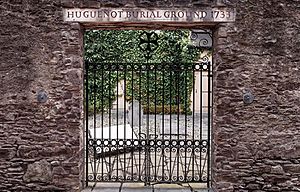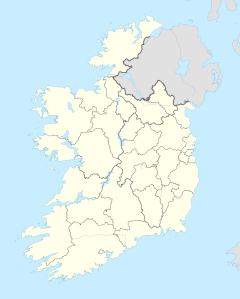Huguenot Cemetery, Cork facts for kids
Quick facts for kids Huguenot Cemetery |
|
|---|---|
 |
|
| Religion | |
| Affiliation | Huguenot |
| Ecclesiastical or organizational status | Closed |
| Year consecrated | 1733 |
| Location | |
| Location | Cork, Ireland |
The Huguenot Cemetery in Cork, Ireland, is a special old graveyard. It was made between 1710 and 1733 for the Huguenot people living in Cork. Huguenots were French Protestants who had to leave their home country because of their religion. This cemetery is thought to be one of only two Huguenot graveyards left in western Europe.
A Safe Place for Huguenots
Many years ago, in the 1600s, Huguenots faced tough times in France. They were Protestants, and the government wanted everyone to be Catholic. This led to a lot of unfair treatment and danger for them. In 1685, a law called the Edict of Nantes was cancelled. This meant Huguenots lost their freedom to practice their religion. Because of this, about 5,000 Huguenots left France and came to Ireland to find safety.
Hundreds of these brave refugees settled in the city of Cork. They built a new community there. In an area now known as French Church Street, they created a school and a place to help those in need. They also needed a place to bury their loved ones. That's why the Huguenot Cemetery was created.
This cemetery holds the remains of some very important Huguenot families from Cork. It's even believed that a former Lord Mayor of Cork is buried here. People continued to use the graveyard for burials until 1901. Today, the cemetery is a protected site, known as a recorded monument. This means it's an important historical place that needs to be looked after.



